AMD Beema/Mullins Architecture & Performance Preview
by Anand Lal Shimpi on April 29, 2014 12:00 AM ESTThe Discovery Tablet
AMD is in a difficult position these days. Traditionally it was the cheaper alternative to Intel, but with Bay Trail Intel made a serious push into segments where OEMs would traditionally use lower cost AMD silicon. In an attempt to be more than a lower cost Intel alternative, AMD is throwing its hat into the form factor reference design race and offering OEMs an example of a full, ideal, high performance implementation of its silicon. One such example is AMD’s Discovery Tablet, an 11.6-inch 1080p Windows 8.1 tablet design that features AMD’s highest end A10 Micro-6700T Mullins silicon. The tablet is a bit larger and heavier than I’d like. If AMD is going to build a reference platform I’d prefer it to be a form factor I’d actually use, which in a tablet is going to be something smaller than 11.6-inches. If you are trying to cover both tablet and 2-in-1 form factors however, the Discovery Tablet makes sense.
I was allowed to spend a few hours benchmarking AMD’s Discovery Tablet. Unfortunately the device wasn’t instrumented for power testing, nor was there enough time to run any battery life tests on it, so the usefulness of these numbers is limited. We already know that AMD’s idle power isn’t as good as smartphone silicon, but for some of these value Windows 8.1 devices it may still be good enough.
Tablet JS/Web Browser Tests
We'll start with our usual set of JavaScript tests. Here we see AMD's A10 Micro-6700T outperform everything on the list. Whether we're talking about Bay Trail or Apple's A7, the 6700T pulls ahead by a decent margin. Once again the big question is how much power is being drawn to deliver this performance. Unlike Intel's Bay Trail preview, AMD didn't have any instrumented Discovery tablets setup for us to monitor power consumption. I suspect AMD's power consumption is competitive, but my guess is it isn't similarly class leading.
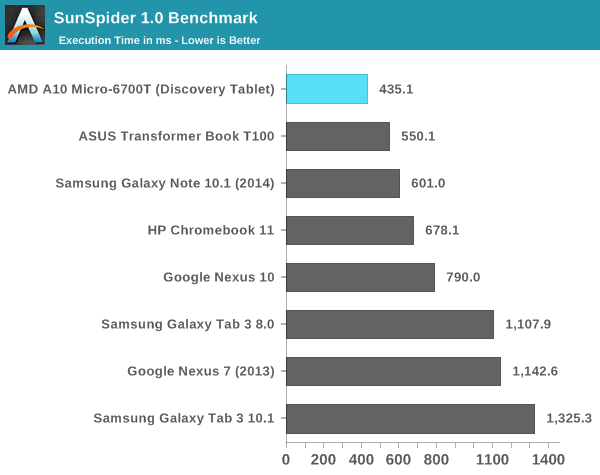
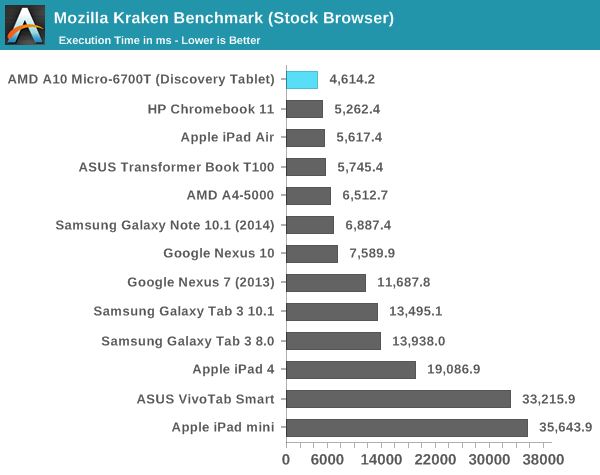

CPU Performance
For these next tests I turned to some of our more traditional Windows PC benchmarks. I looked at Cinebench 11.5 to get an idea for how single and multithreaded performance have changed since last year.
Looking at single threaded performance we immediately see the benefits of AMD's new boosting capabilities. The Puma+ cores are 35% faster than Intel's Silvermont cores, and can deliver nearly 80% of the performance of AMD's Piledriver cores found in Trinity. I threw some Llano results in here as well - Mullins offers around 85% of the performance of Llano.
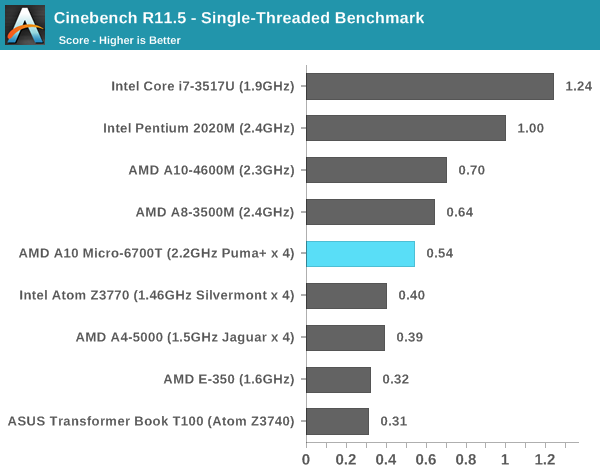
Multithreaded performance is pretty evenly matched between Bay Trail and Mullins here. Note that Mullins manages to deliver very similar performance to Kabini, despite coming in at substantially less power. The comparison to Brazos (E-350) is laughable, Mullins is substantially faster.
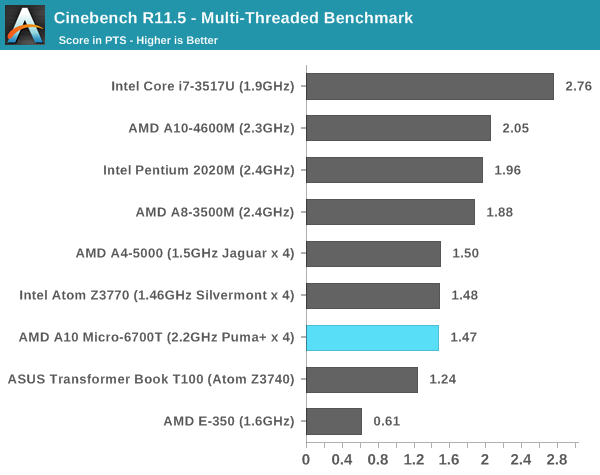
PCMark 7 gives us a better look at the overall performance of the Discovery tablet hardware. Here we do see it lose ground to the Kabini notebook (A4-5000) as well as the Bay Trail devices. It's unclear to me if we are seeing the thermal limits of the hardware (this is a longer test) or if there are other elements at work here (e.g. storage performance limits).
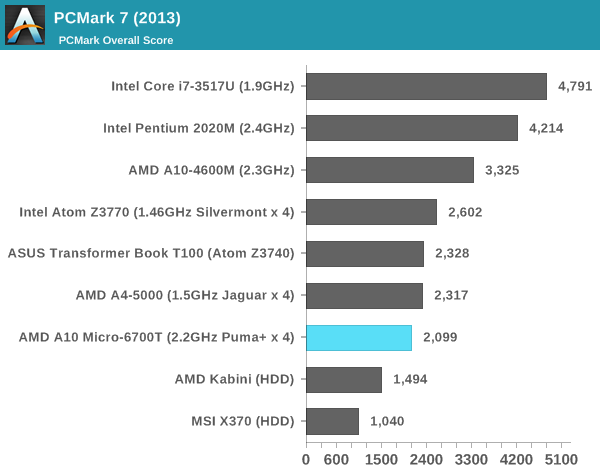
GPU Performance
We don’t actually have any Bay Trail devices in our Laptop 2013 bench, they are all in our Tablet 2013 category, which unfortunately uses different benchmarks. To make a long story short, we have Bay Trail vs. Kabini data, and Kabini vs. Mullins data. Thankfully the comparison between Bay Trail and Mullins is pretty easy to make.
AMD’s 4.5W TDP A10 Micro-6700T delivers roughly the same GPU performance as a 15W A4-5000. The A4-5000 also ends up being anywhere from 50% to over 2x the speed of Bay Trail when it comes to GPU performance, so you can expect Mullins to hold roughly the same advantage.
Compared to the old 35W Trinity, Mullins still has a ways to go. Trinity delivers roughly 2x the performance of Mullins, although at nearly 10x the TDP.
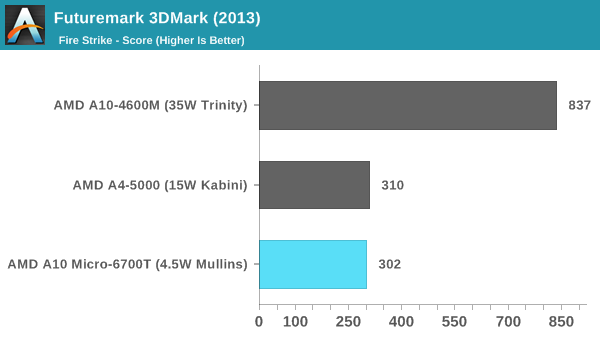
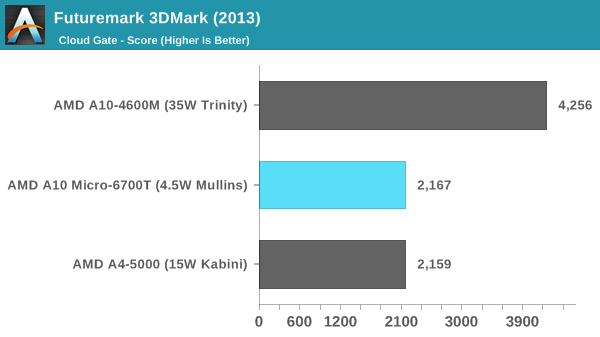
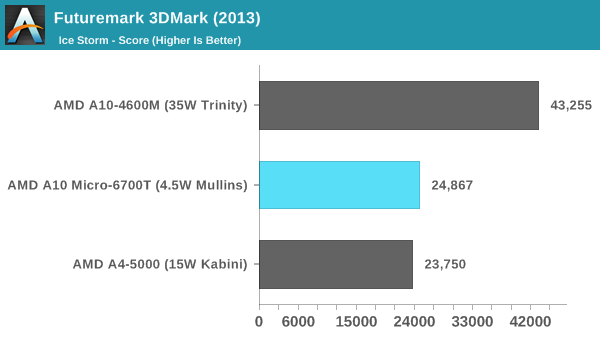


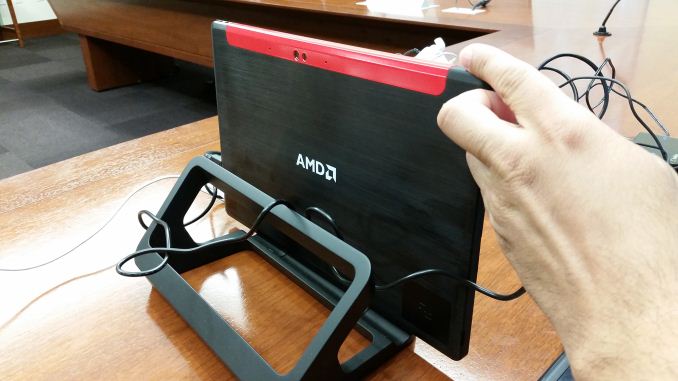
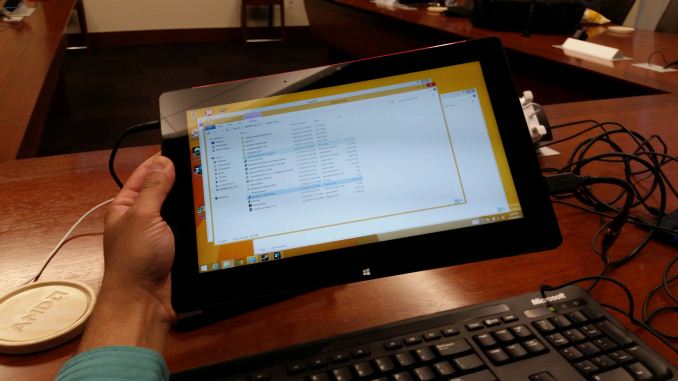














82 Comments
View All Comments
Nintendo Maniac 64 - Tuesday, April 29, 2014 - link
Hmmm, sounds like the AMD equivalent of an Intel "tick", especially considering that the IPC between Puma+ and Jaguar is unchanged.Interestingly enough, this would mean that the PS4 and Xbone could use Puma+ cores in the future (with turbo disabled obviously).
nevertell - Tuesday, April 29, 2014 - link
Why would they need to disable turbo? I believe nobody is hitting the CPU performance limits just to have a fps limit or rely on the raw performance for timing, whereas this could improve some load times or improve performance during context switching.mwarner1 - Tuesday, April 29, 2014 - link
Consoles have fixed performance hardware to prevent games & applications performing differently on different hardware revisions. If you bought a PS4 today and then next week a new version was released (but likely not announced) that made games smoother / more playable then you would have the right to be annoyed.Havor - Tuesday, April 29, 2014 - link
No the main reason for fixed performance hardware is that developers dont have too add code or scalable textures to adjust or performance differences.And thus they have a more efficient single spec code, that dose not have to adjust to hardware spec.
nathanddrews - Tuesday, April 29, 2014 - link
Yeah, I highly doubt they'll switch architectures since it has never happened before. Power savings and console redesigns come from shrinks and on-die packaging.Samus - Wednesday, April 30, 2014 - link
There's nothing stopping Sony or Microsoft from launching a "performance edition" PS4 or XBOX One with a hardware bump that simply added antialiasing, etc, to games.This has already been done over the years with Nintendo offering the 4MB RAMBUS upgrade for the N64, and various performance storage options for XBOX 360/PS3 to assist load times of disc-based games. The SSD-edition of the 360 can load games/levels virtually instantly compared to running from disc or disk.
mfoley93 - Wednesday, April 30, 2014 - link
These aren't really higher performance though, just lower power. They could just lower the clock to offset whatever slight performance gains there are to equal the launch products.nathanddrews - Wednesday, April 30, 2014 - link
1. When Microsoft or Sony want to increase performance, they only do so via software updates that don't destabilize the platform as a whole. Neither can afford to break millions of consoles with a bad update or segregate the community into two camps. On the other hand, if developers of individual games find a way to improve framerates or AA, they can submit updates for download - but only after it is tested by the console manufacturers.2. I have the 4MB upgrade for my N64, only TWO games required it, a very small percentage of N64 games supported it, and even fewer truly benefited from it. It's mild success was due entirely to ZMM, DK, and PD, but Nintendo hasn't tried anything like it since. (Lest we forget the 64DD...)
3. Only Sony lets you install any drive you want. Most reviews from those that have upgraded to SSDs say it just isn't worth it. It's a consumer option, not something Sony changes at the platform level. The games still run at the same speed with the same textures.
4. There is no consumer "SSD Edition" Xbox 360 and they won't let you install one (officially). Are you referring to the 4GB Slim? That's not an SSD and most 360 games are too big to install onto it.
5. I have yet to see a console SSD upgrade result in anything instantaneously... except regret. :D
Kevin G - Wednesday, April 30, 2014 - link
Consoles are to be 'fixed spec' so that game developers know exactly what to expect in terms of hardware. The lone exception has been storage capacity. The N64 memory expansion is an excellent example of why developers aim for the lower guaranteed spec: only three games required it with a handful of games that'd use it if present.Both MS and Sony could come out with a hardware revision that does a bit more outside of gaming without impacting game developers. For example, MS could release an Xbox One with a digital tuner + DVR hardware. Such a change would have no impact to the gaming side of things. Ditto if MS or Sony were to add backwards compatibility via hardware: it'd be unavailable to use in an Xbox One or PS4 game.
Arbee - Thursday, May 1, 2014 - link
There was a late revision of the original PlayStation where the GPU got significantly faster for some operations, which resulted in higher frame rates in some games. (This was when the debug units switched from blue to green, in order to differentiate).